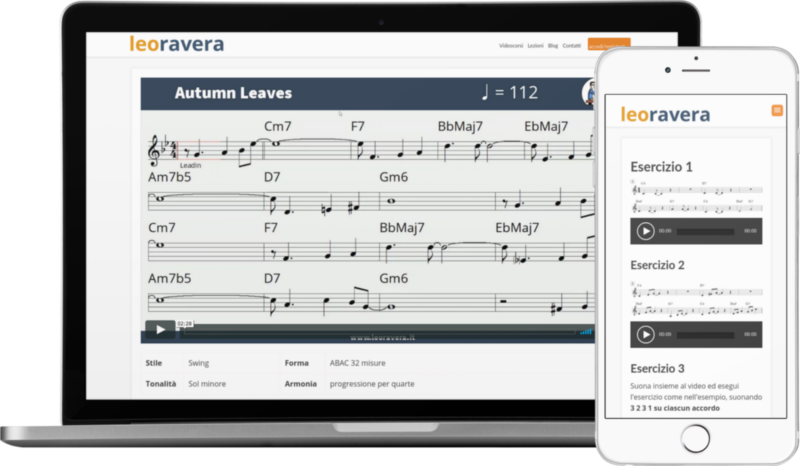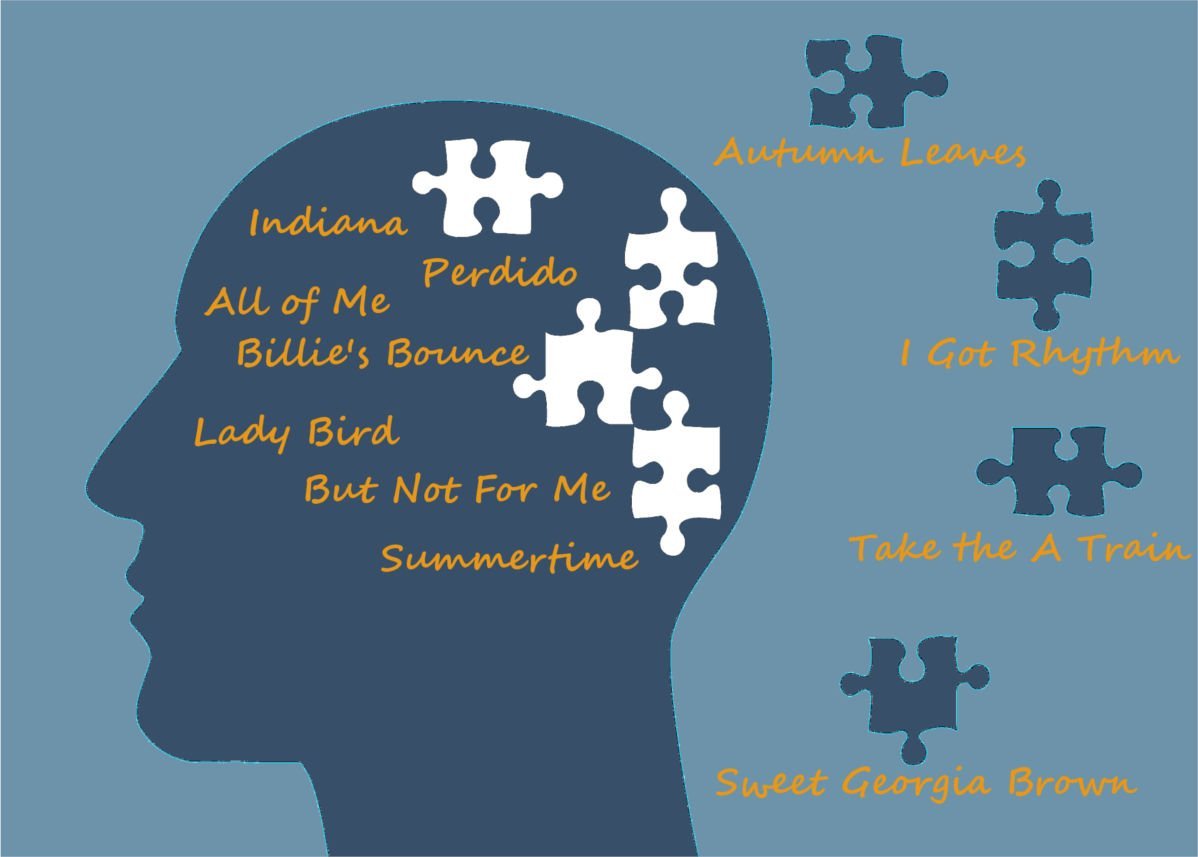Do you want to learn a number of jazz standards by heart but don’t know where to start? Perhaps you’ve tried jamming with more experienced musicians and realised how important it is to know a number of jazz tunes by heart. In this lesson I will provide a comprehensive guide to building a repertoire of 100 jazz standards from scratch.
Playing many jazz standards by heart is essential for those who want to play jazz. Studying the repertoire has a practical purpose, taking part in jam sessions without having to constantly say ‘I don’t know this one’.
Learning jazz tunes by heart is also and above all about getting to know the language, assimilating the stylistic elements typical of each era. In order to learn 100 jazz standards by heart, I propose a selection of songs divided into four groups, in progressive order of difficulty.
How to learn a jazz piece by heart
If you want to learn many jazz standards by heart, you have to plan a special study that consists of several steps: choosing the song, listening to historical recordings, analysing the harmony, studying the melody and finally reviewing – maintaining the repertoire. Let’s analyse each step.
1. The right repertoire to start with
To begin with, I recommend choosing pieces from the classical or swing period. These pieces are simpler, have singable melody and predictable harmonic progression that are easy to remember. Authors such as George Gershwin, Harold Arlen, Irving Berlin, Rodgers & Hart, Jerome Kern, Cole Porter etc. have each produced hundreds of songs. Inevitably, many harmonic formulas are repeated similarly in several songs and this will help you not only to memorise the pieces more easily, but also to better understand the repertoire of the classical or swing period.
We call the classical period the 1920s, when jazz became popular, and the swing period the 1930s, the era of the big dance orchestras. Although simpler than more recent pieces, many pieces from these eras are masterpieces which all jazz musicians have dealt with.
2. Before you play… listen!
If you want to memorise and remember a large number of jazz standards over time, listening is a phase that you absolutely cannot neglect. However, it is not enough to listen to jazz in general, you will have to do targeted listening.
Playing jazz is also and above all about reinterpreting pieces in a new and original way, so trying to learn pieces by listening to recent interpretations is not a good idea. Listen to the original versions of the pieces, and for the repertoire of standards listen to the sung versions.
Singers are usually more respectful of the original melody, if only because they have to recite the words and cannot therefore distort the metrics too much. In particular, I recommend the interpretations of Frank Sinatra, who often changed the rhythm of the phrases but rarely altered the pitch of the sounds. Among female voices, I recommend Ella Fitzgerald’s famous Songbook.
3. Analyse the pieces you are studying
First of all try to analyse the structure of the pieces: many pieces respect simple formulas such as AABA, ABAC, AABC, lasting 32 measures. From this point of view, the jazz repertoire is very simple and predictable. This should not come as a surprise because improvisation is difficult enough in itself, so a repertoire that at least in form was logical and repetitive prevailed.
Then try to analyse the harmony, recognising the simplest formulas: cadences, modulations, symmetries. For this you need to have some basic knowledge of functional harmony, so that you can recognise the most common formulas when they occur in a piece.
Finally, iyou should also analyse the melody and try to find recurring and repetitive elements in it. For example, the jazz song All the Things You Are, which is not the simplest from a harmonic point of view, has a melody that almost always insists on the 3rd of each chord. Recognising this kind of situation is very useful, as it will make it easier for you to remember the themes.
4. How to study a jazz standard
Studying music requires patience, and love. Have you ever heard a classical pianist play a Bach fugue with the notes ‘more or less right’? Many aspiring jazz musicians do just that, playing themes loosely while waiting for the time to come to improvise. This is a careless and irresponsible attitude: a badly played theme creates uncertainty in the bandmates, annoyance in the audience, and ultimately undermines the improvisation that will follow.
Studying themes takes time and effort, but it develops musicality, musical ear and melodic sense, as well as mastery of styles. While you are learning to play the themes, or immediately afterwards, try to memorise the chord sequence. To do this, do some simple exercises:
- Play the root of each chord as a bassist would.
- On each chord, arpeggiate the triad in ascending and descending mode
- Play full seventh chords
In order to study jazz standards, it can be useful to use backing tracks with drum, bass and piano accompaniment. The best known backing tracks are the Aebersold play alongs, but personally I’ve never liked them because they are too fast and complicated. I’ve always preferred more basic backing tracks like the ones you can build with applications like Band in a Box.

Backing tracks are a useful tool for practising. You can also find some in our improvisation course.
5. Go over your jazz repertoire… not to forget it
Once you have learnt a piece, try not to forget it! If you don’t take the time to retain the pieces you have learnt, you will inevitably start to forget them. Here are some tips on how to keep your hard-won repertoire:
- Keep a list of the pieces you are studying/have studied.
- Periodically review the entire repertoire, if possible at least once a month
- Write down the ‘new’ pieces separately, i.e. those you are adding to your repertoire. Try to revise these at least once a week.
- Don’t merely repeat but try to improve the pieces you already know, studying the harmony better and better and trying to play the same piece in different keys.
- Try to study homogeneous groups of pieces, learning several pieces by the same author or from the same period.
Una volta che avrai acquisito un metodo efficace per imparare a memoria un pezzo jazz, potrai iniziare a lavorare sul repertorio e passare da uno a cento, nel giro di pochi mesi.

Learn 1 to 100 jazz standards by heart
Below you will find a list of 100 jazz standards divided by difficulty and period, to make studying and memorising them as easy as possible.
When it comes to music, any list will inevitably be partial and incomplete, mine clearly being no exception. In compiling this list of jazz standards I have chosen:
- Jazz songs most often performed by top jazz musicians
- The most frequently played jazz songs in jam sessions (at least those I have attended)
- Songs composed by the most important composers of the various periods: traditional jazz, swing, bebop
- Songs that provide some variety in terms of form and harmonic structure
Learning the jazz repertoire: a work method
Learning jazz standards by heart may initially seem exhausting. In this type of study, the beginning is the hardest part, which is why the number of pieces in each group is increasing, as is the difficulty. With this list, I therefore propose to the aspiring jazz musician a working method based on the principle of progressive difficulty.
You should move on to the next group only when you have mastered the previous one, and continue to memorize all the pieces you have studied. This type of study is not simply quantitative; once you have mastered the first 30-40 pieces, the difficulty of learning new ones is progressively less, as you develop sensitivity to recurring harmonic formulas and memory for the typical elements of the various composers and styles.
Now we are ready to start learning 100 jazz standards. We start with the first group, consisting of ten tunes.
Jazz standards, group 1
The jazz standards of the first group have a simple form (16 or 32 measures), modulations at close tonalities, and the themes are easy to remember. These jazz standards belong mainly to the Swing period, i.e. the 1930s.
| N. | Title and Author | Form | Key | Style |
| 1 | All of Me (Marks-Simons) | 32 bars ABAC | F | Swing |
| 2 | Autumn Leaves (Mercer-Kosma) | 32 bars AABA | Gm | Swing |
| 3 | Blue Bossa (K.Dorham) | 16 bars | Cm | Latin |
| 4 | Blues Skies (I.Berlin) | 32 bars AABA | C | Swing |
| 5 | C Jam Blues (D.Ellington) | 12 bars blues | C | Swing |
| 6 | Fly Me To The Moon (B.Howard) | 32 bars ABAC | C | Swing |
| 7 | Lady Bird (T.Dameron) | 16 bars | C | Bebop |
| 8 | Summertime (G.Gershwin) | 16 bars | Dm | Swing |
| 9 | Take the A train (B.Strayhorn) | 32 bars AABA | C | Swing |
| 10 | There Is No Greater Love (I.Jones) | 32 bars AABA | B♭ | Swing |
When you have memorised these ten jazz pieces and have gone over them properly, you can move on to the second group. The work on the first 10 standards is the hardest. If you have the patience to complete it, you will find that learning the second group is not as difficult.
Discover our improvisation course
Perhaps you might be interested in the course on learning to improvise by playing twelve well-known jazz standards.
Jazz standard, group 2
The jazz standards of the second group also have a simple form, modulations to close or distant keys, themes of medium difficulty. The pieces belong mainly to the Swing period.
| N. | Title and author | Form | Key | Style |
| 1 | Billies’ Bounce (C.Parker) | 12 bars, blues | F | Bebop |
| 2 | Blue Moon (Rodgers) | 32 AABA | C | Swing |
| 3 | But Not For Me (G.Gershwin) | 32 ABAC | E♭ | Swing |
| 4 | East of The Sun (J.Green) | 32 ABAC | G | Swing |
| 5 | Everything Happens to Me (M.Dennis) | 32 ABAC | B♭ | Ballad |
| 6 | Garota de Ipanema (A.C.Jobim) | 32 AABA | F | Bossanova |
| 7 | Honeysuckle Rose (F.Waller) | 32 AABA | F | Swing |
| 8 | How High the Moon (M.Lewis) | 32 ABAC | G | Swing |
| 9 | I’ve Got Rhythm (G.Gershwin) | 32 AABA | B♭ | Swing |
| 10 | In a Mellow Tone (D.Ellington) | 32 ABAC | A♭ | Swing |
| 11 | Misty (E.Garner) | 32 AABA | E♭ | Ballad |
| 12 | On Green Dolphin Street (B.Kaper) | 32 ABAC | E♭ | Swing |
| 13 | Out of Nowhere (J.Green) | 32 ABAC | G | Swing |
| 14 | Perdido (J.Tizol) | 32 AABA | B♭ | Swing |
| 15 | Satin Doll (D.Ellington) | 32 AABA | C | Swing |
| 16 | Someday My Prince Will Come (F.Churchill) | 32 ABAC | B♭ | Swing |
| 17 | Stolen Moments (O.Nelson) | 12 bars, blues | Cm | Hard bop |
| 18 | Sweet Georgia Brown (Bernie-Pinkard) | 32 ABAC | A♭ | Swing |
| 19 | Tune Up (M.Davis) | 32 ABAC | D | Bebop |
| 20 | What Is This Thing Called Love (C.Porter) | 32 AABA | C | Swing |
Once you have completed this second group, you can prepare to learn more complex jazz pieces by heart. Let’s see which ones.
Group 3, thirty jazz standards from the swing or bebop period
The jazz standards in the third group are on average more difficult than the previous ones. In particular you will find:
- Jazz pieces with a more complex form than the AABA classics. For example, pieces with a duration of 36 measures
- Numerous modulations
- Themes that are more difficult to memorise, particularly those from the bebop period
If you have difficulty learning these pieces, I recommend that you rigorously apply the procedure for memorising a jazz standard, which you will find in the first part of the article. In particular, don’t neglect the harmonic analysis and listening phases. You can’t expect to learn a jazz piece by heart if you haven’t understood it (harmonic analysis) and if you haven’t listened to it many (many!) times.
Here, is the third group of jazz standards:
- A Foggy Day (G.Gershwin)
- All the Things You Are (J.Kern)
- Black Orpheus (L. Bonfa)
- Bluesette (T.Thielemans)
- Body and Soul (J.Green)
- Bye Bye Blackbird (R.Henderson)
- Corcovado (A.C.Jobim)
- Easy To Love (C.Porter)
- Groovin’ High (D.Gillespie)
- I Hear a Rhapsody (G.Fragos)
- I Should Care (S.Cahn)
- If I Were A Bell
- It Could Happen to You (V.Heusen)
- It’s You Or No One (J.Styne)
- Jeannine (D.Pearson)
- Just Friends (J.Klenner)
- Like Someone in Love (V.Heusen)
- Lover Man (J.Sherman)
- My Funny Valentine (Rodgers)
- Night and Day (C.Porter)
- Prelude To a Kiss (D.Ellington)
- Secret Love (Sherwood)
- Softly as in a Morning Sunrise (S.Romberg)
- Stella By Starlight (V.Young)
- Tea for Two (V.Youmans)
- The Days of Wine and Roses (H.Mancini)
- There Will Never Be Another You (H.Warren)
- Up Jumped Spring (F.Hubbard)
- Wave (A.C.Jobim)
- Whisper Not (B.Golson)
Group 4, forty jazz standards of all genres and styles
The last group consists of 40 pieces, in which we find modulations to near and far keys as well as complex themes. Many songs belong to the swing or bebop period, others were composed later and belong to the categories of hard bop or modal jazz.
- Anthropology (C.Parker)
- Autumn In New York (V.Duke)
- Blue In Green (B.Evans)
- Blues for Alice (C.Parker)
- Blues March (B.Golson)
- Cherokee (R.Noble)
- Confirmation (Parker)
- Desafinado (A.C.Jobim)
- Dewey Square (C.Parker)
- Donna Lee (M.Davis)
- Giant Steps (J.Coltrane)
- Good Bait (T.Dameron)
- Have You Met Miss Jones? (R.Rodgers)
- Footprints (W.Shorter)
- I Mean You (T.Monk)
- I Remember Clifford (B.Golson)
- I’ll Remember April (G.De Paul)
- If You Could See Me Now (T.Dameron)
- Invitation (B.Kaper)
- Just One of Those Things (C.Porter)
- Line For Lyons (G.Mulligan)
- Lush Life (B.Strayhorn)
- Milestones old (M.Davis)
- My Favorite Things (Rodgers)
- Night in Tunisia (D.Gillespie)
- Oblivion (B.Powell)
- Oleo (S.Rollins)
- Recordame (J.Henderson)
- ‘Round Midnight (T.Monk)
- Ruby My Dear (T.Monk)
- Soul Eyes (M.Waldron)
- Speak Low (K.Weil)
- Speak No Evil (W.Shorter)
- Star Eyes (G.De Paul)
- Stardust (H.Carmichael)
- The Song is You (J.Kern)
- The Way You Look Tonight (J.Kern)
- Waltz for Debby (B.Evans)
- You Go To My Head (J.Coots)
- You Must Believe In Spring (M.Legrand)
I hope that this guide for learning 100 jazz standards by heart will help you to study and explore the wonderful repertoire of jazz music. If you have any suggestions for improving this lesson, please write a comment at the end of the page. If you need help studying jazz standards or jazz piano, please write to me to arrange a lesson via Skype. See you soon!


